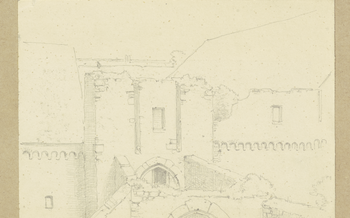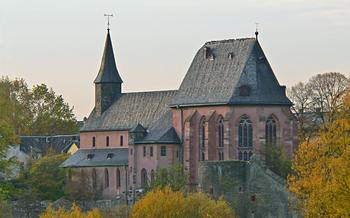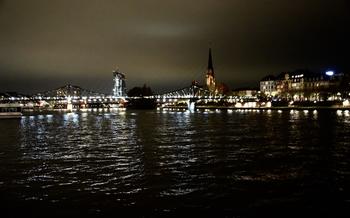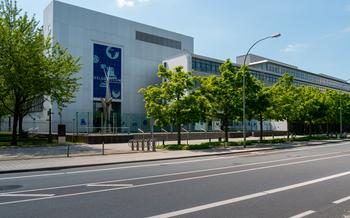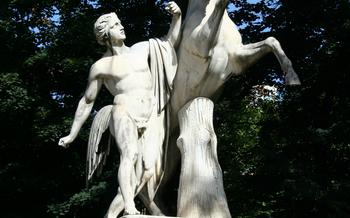
European Central Bank
- Unveiling Frankfurt's Financial Heart: The European Central Bank
- Navigating the ECB: A Maze of Intriguing Exhibits
- Delving into Monetary Policy: Unraveling the ECB's Role
- Witnessing the Heart of European Finance: The Decision-Making Process
- Peering into the Future: The ECB's Vision for Europe's Financial Landscape
- The ECB's Commitment to Public Engagement: Demystifying Central Banking
- A Journey Through Time: The Historical Context of the ECB
- The ECB's Contribution to European Integration: Fostering Stability and Growth
- The ECB's Global Influence: Shaping International Monetary Policy
- Inspiring Young Minds: The ECB's Educational Outreach
- A Glimpse Behind the Scenes: Exploring the ECB's Unique Architecture
- A Walk Through Frankfurt's Financial District: Unveiling the City's Economic Vibrancy
- Indulge in Frankfurt's Culinary Delights: A Culinary Journey through German Cuisine
- Exploring Frankfurt's Cultural Treasures: A Tapestry of Art, History, and Tradition
- Insider Tip: Unveiling Frankfurt's Hidden Gems
Unveiling Frankfurt's Financial Heart: The European Central Bank
Frankfurt, Germany's financial capital, plays a pivotal role in shaping the economic landscape of Europe. At the heart of this financial hub lies the European Central Bank (ECB), a majestic institution that oversees the monetary policy of the eurozone, comprising 20 member states. Established in 1998, the ECB holds the responsibility of maintaining price stability and ensuring the smooth functioning of the financial system within the European Union. Occupying a prominent position on Frankfurt's skyline, the ECB's striking architecture symbolizes its significance as a key player in the world of finance.
Frankfurt's emergence as a financial powerhouse can be traced back to the Middle Ages when it served as a major trading center. Over the centuries, the city's reputation as a financial hub grew, attracting numerous banks and financial institutions. Today, Frankfurt boasts a modern skyline dominated by gleaming skyscrapers, reflecting its status as a global financial center. The ECB's presence in Frankfurt further cements the city's position as a pivotal player in the world of finance.
Navigating the ECB: A Maze of Intriguing Exhibits
The ECB offers visitors a captivating journey through the world of monetary policy and European finance. Interactive displays and multimedia presentations bring the history of money and the workings of the ECB to life. Visitors can learn about the evolution of money, from ancient coins to modern digital currencies, and discover the mechanisms that regulate our financial system.
Unveiling the history of monetary policy in Europe, the ECB showcases how central banks have shaped the economic landscape over centuries. Visitors can explore the challenges and successes of monetary policy in different historical periods and gain insights into the complexities of managing inflation and economic growth.
To understand the ECB's role in ensuring financial stability, visitors can delve into the decision-making process of the ECB's Governing Council. Interactive simulations demonstrate the factors considered when setting interest rates and other monetary policy measures, highlighting the delicate balance between price stability and economic growth.
The ECB also provides a glimpse into the future of monetary policy, showcasing its ongoing research and innovation. Visitors can learn about the latest developments in financial technology and explore how the ECB is adapting to meet the challenges of a rapidly changing world.
Delving into Monetary Policy: Unraveling the ECB's Role
Monetary policy, a complex yet crucial aspect of the European Central Bank's (ECB) responsibilities, plays a pivotal role in steering the course of the European economy. The ECB, as the guardian of monetary stability in the Eurozone, utilizes a range of tools to regulate the money supply, ensuring price stability and fostering economic growth.
Understanding Monetary Policy: Monetary policy encompasses the actions taken by the ECB to influence the quantity and availability of money in the economy. Through its decisions, the ECB aims to maintain price stability, defined as an inflation rate of close to but below 2%.
ECB's Toolkit for Monetary Policy: To achieve its monetary policy objectives, the ECB employs several instruments. These include:
Interest Rates: The ECB sets key interest rates, which influence the cost of borrowing for banks and businesses. Adjustments to interest rates can stimulate or contract economic activity. Quantitative Easing: During economic downturns, the ECB may engage in quantitative easing, purchasing government bonds and other assets to increase the money supply and boost lending. Reserve Requirements: The ECB sets reserve requirements, which dictate the amount of money banks must hold in reserve, influencing the availability of funds for lending.
Impact of Monetary Policy: The ECB's monetary policy decisions have far-reaching consequences for the Eurozone economy. By regulating the money supply, the ECB can influence:
Economic Growth: Appropriate monetary policy settings can promote economic growth by encouraging investment and consumption. Inflation: The ECB's focus on price stability helps to keep inflation under control, safeguarding the purchasing power of consumers and businesses. Financial Stability: Effective monetary policy contributes to financial stability by reducing the risk of financial imbalances and crises.
Challenges in a Globalized Economy: In a globalized economy, the ECB faces several challenges in implementing monetary policy effectively:
External Factors: Global economic conditions, such as trade policies and geopolitical events, can influence the effectiveness of monetary policy. Heterogeneous Economies: The Eurozone comprises diverse economies with different structural characteristics, making it challenging to tailor monetary policy to all member states. Financial Market Integration: The interconnectedness of global financial markets can transmit financial shocks across borders, complicating monetary policy decisions.
Witnessing the Heart of European Finance: The Decision-Making Process
The ECB's decision-making process lies at the core of its operations, shaping monetary policy for the entire eurozone. The ECB's governing bodies, comprising the Executive Board and the Governing Council, play crucial roles in formulating and implementing monetary policy decisions. The Executive Board, consisting of the President, Vice President, and four other members, is responsible for the day-to-day management of the ECB and prepares policy proposals for the Governing Council's consideration.
The Governing Council, the ECB's supreme decision-making body, convenes regularly to set interest rates, adjust monetary policy instruments, and ensure price stability within the eurozone. It comprises the six Executive Board members and the governors of the national central banks of the eurozone countries.
The decision-making process is characterized by thorough analysis, open discussion, and consensus-building among the Governing Council members. They evaluate economic data, assess risks, and consider various policy options before reaching a collective decision. The independence of the ECB is paramount in ensuring that monetary policy decisions are made solely based on economic considerations, free from political or external influences.
Transparency is a fundamental principle guiding the ECB's decision-making process. The ECB regularly publishes its monetary policy decisions, along with detailed accounts of the discussions and rationale behind them. This transparency fosters accountability, enhances public understanding, and promotes trust in the ECB's decision-making process.
Peering into the Future: The ECB's Vision for Europe's Financial Landscape
The ECB's vision for the future of European finance is guided by several strategic objectives. One key goal is to maintain price stability, ensuring that inflation remains low and stable. This fosters a favorable environment for economic growth and financial stability. The ECB also aims to promote a sound and efficient financial system, encouraging financial innovation while mitigating risks and ensuring the smooth functioning of financial markets. Furthermore, the ECB is committed to supporting sustainable growth and employment in the Eurozone, recognizing the vital role of a stable financial system in fostering economic prosperity.
The ECB's vision must adapt to the evolving challenges and opportunities of a dynamic financial landscape. In an increasingly globalized economy, the ECB seeks to strengthen its cooperation with other central banks and international organizations to address global economic challenges and promote financial stability. The ECB is committed to fostering innovation and embracing technological advancements, recognizing the potential of fintech to enhance efficiency and transparency in financial markets. By adapting and innovating, the ECB aims to ensure that its policies remain effective and responsive to the changing needs of the European economy.
The ECB's vision for the future of European finance holds significant implications. A stable and efficient financial system is crucial for economic growth, job creation, and overall prosperity in the Eurozone. The ECB's commitment to price stability, financial soundness, and sustainable growth positions the organization as a key player in shaping the economic destiny of Europe. By pursuing its strategic objectives and adapting to the evolving financial landscape, the ECB aims to contribute to a prosperous and resilient European economy, benefiting businesses, individuals, and society as a whole.
The ECB's Commitment to Public Engagement: Demystifying Central Banking
The European Central Bank (ECB) recognizes the importance of public awareness and education in fostering understanding and trust in its role and responsibilities. To this end, the ECB has undertaken several initiatives to engage with the public and demystify the often-complex world of central banking.
One key initiative is the ECB's Visitor Centre, located in the heart of Frankfurt's financial district. The Visitor Centre offers interactive exhibits, multimedia presentations, and guided tours, providing visitors with a comprehensive overview of the ECB's history, mandate, and operations. Through these interactive experiences, visitors gain insights into the decision-making process, the tools used by the ECB to regulate the money supply, and the impact of monetary policy on the European economy.
The ECB also actively engages with the public through its website, social media platforms, and educational programs. The ECB's website provides a wealth of information on its activities, policies, and publications, making it a valuable resource for researchers, students, and the general public. The ECB's social media channels offer a more informal and interactive platform for sharing news, insights, and behind-the-scenes glimpses of the institution.
To promote financial literacy and economic education, the ECB collaborates with universities, schools, and educational institutions across Europe. The ECB offers a range of educational resources, including interactive online modules, videos, and publications, designed to help students and educators understand the complexities of central banking and its impact on society.
Through these initiatives, the ECB strives to demystify central banking and foster a greater understanding of its role in ensuring financial stability and economic growth in Europe. By engaging with the public, the ECB aims to build trust and confidence in its policies and contribute to a more informed and financially literate society.
A Journey Through Time: The Historical Context of the ECB
The European Central Bank (ECB) is a relatively young institution, established in 1998 with the primary objective of maintaining price stability in the Eurozone. However, its roots can be traced back to the early days of central banking in Europe.
The concept of central banking emerged in the 17th century, with the establishment of the Bank of England in 169Central banks were initially created to serve as lenders of last resort to commercial banks, ensuring the stability of the financial system. Over time, their role expanded to include regulating the money supply and managing interest rates.
In the 20th century, the need for a coordinated approach to monetary policy in Europe became increasingly apparent. The Bretton Woods Agreement of 1944 established the International Monetary Fund (IMF) and the World Bank, laying the foundation for international cooperation in economic and financial matters.
The European Economic Community (EEC), established by the Treaty of Rome in 1957, marked a significant step towards European integration. However, it was not until the Maastricht Treaty of 1992 that the framework for a single European currency and a European central bank was established.
The Maastricht Treaty laid the foundation for the creation of the European System of Central Banks (ESCB), which included the ECB and the national central banks of the EU member states. The ECB was officially established on June 1, 1998, and assumed responsibility for monetary policy in the Eurozone on January 1, 199
The early years of the ECB were marked by a number of challenges, including the need to establish a credible monetary policy framework and to coordinate monetary policy with the national central banks of the Eurozone. However, the ECB successfully navigated these challenges and has played a key role in maintaining price stability and fostering economic growth in the Eurozone.
The ECB's Contribution to European Integration: Fostering Stability and Growth
The European Central Bank (ECB) plays a pivotal role in fostering stability and growth within the European Union (EU). As the central bank of the eurozone, the ECB is responsible for maintaining price stability and ensuring the smooth functioning of the financial system. Through its monetary policy decisions and initiatives, the ECB contributes to the economic convergence among EU member states and promotes sustainable economic growth.
One of the key objectives of the ECB is to maintain price stability within the eurozone. By keeping inflation under control, the ECB creates a favorable environment for economic growth and investment. Price stability encourages businesses to plan for the future, make long-term investments, and expand their operations. It also protects consumers from the erosive effects of inflation on their purchasing power.
The ECB's monetary policy decisions also impact economic growth. By adjusting interest rates and implementing quantitative easing measures, the ECB can influence the availability and cost of credit in the economy. Lower interest rates can stimulate borrowing and investment, leading to increased economic activity. The ECB's actions aim to strike a balance between maintaining price stability and supporting economic growth.
Furthermore, the ECB contributes to European integration by promoting financial integration within the EU. The eurozone, with its single currency and monetary policy, has eliminated currency exchange rate risks and created a more stable and integrated financial market. This has facilitated cross-border trade and investment, leading to increased economic efficiency and growth. The ECB's efforts to harmonize financial regulations and promote cross-border cooperation among financial institutions further contribute to financial integration and the overall stability of the EU financial system.
The ECB's Global Influence: Shaping International Monetary Policy
The ECB plays a pivotal role in the global economic arena, extending its influence beyond the borders of the European Union. As a key player in international monetary policy, the ECB actively participates in shaping the global financial landscape. Through its cooperation with other central banks and international organizations, the ECB contributes to global economic governance and stability.
The ECB's global influence is reflected in its active engagement with the International Monetary Fund (IMF), the Bank for International Settlements (BIS), and the Financial Stability Board (FSB). These collaborations facilitate the exchange of knowledge, best practices, and policy coordination on a global scale. The ECB's expertise and insights are highly valued in international discussions on monetary policy, financial stability, and economic growth.
Furthermore, the ECB actively participates in global efforts to promote financial stability and prevent financial crises. It collaborates with central banks in emerging and developing economies, sharing its knowledge and experience in financial regulation and supervision. The ECB's commitment to global financial stability extends to its involvement in international initiatives aimed at strengthening financial systems and mitigating systemic risks.
In a globalized financial system, the ECB recognizes the importance of fostering cooperation and coordination among central banks. By engaging with its international counterparts, the ECB contributes to a more stable and resilient global financial system, benefiting not only the European Union but the entire world.
Inspiring Young Minds: The ECB's Educational Outreach
The ECB recognizes the importance of financial literacy and economic education, particularly among the younger generation. To this end, the bank has developed a range of initiatives and programs aimed at engaging with students and educators, fostering a deeper understanding of central banking and its role in the global economy.
The ECB's educational outreach programs include interactive workshops, seminars, and online resources tailored to different age groups and educational levels. Through these initiatives, the ECB aims to demystify central banking, promote economic literacy, and inspire the next generation of economists and policymakers.
The ECB's website offers a wealth of educational resources, including interactive games, videos, and downloadable materials, designed to make learning about central banking fun and engaging. These resources are freely available to educators and students, providing a valuable tool for teaching economics and finance in the classroom.
By investing in educational outreach, the ECB contributes to building a financially literate society, empowering young people to make informed decisions about their finances and the economy. This investment in the future generation helps ensure a more economically aware and engaged citizenry, fostering a deeper understanding of the role of central banks in shaping the financial landscape of Europe and beyond.
A Glimpse Behind the Scenes: Exploring the ECB's Unique Architecture
The European Central Bank's (ECB) headquarters in Frankfurt is a striking example of contemporary architecture, reflecting the institution's significance in the world of finance. Designed by the renowned Austrian architect Coop Himmelb(l)au, the building showcases a bold and distinctive design that has become an iconic landmark in the city's skyline.
The ECB's unique architecture is not merely an aesthetic statement; it also embodies the institution's values and principles. The building's curved facade, reminiscent of a giant wave, symbolizes the ECB's dynamism and its commitment to adapting to the ever-changing financial landscape. The transparent glass exterior represents the ECB's commitment to transparency and accountability, while the spacious interior fosters collaboration and teamwork among its diverse staff.
Beyond its visual appeal, the ECB building incorporates sustainable features that align with the institution's commitment to environmental responsibility. It boasts an innovative energy-saving design, including solar panels and rainwater harvesting systems, demonstrating the ECB's dedication to reducing its carbon footprint.
Inside the building, visitors can admire an impressive art collection that showcases the ECB's appreciation for cultural diversity. The collection features works by renowned artists from across Europe, reflecting the ECB's commitment to fostering a vibrant and inclusive work environment.
The ECB's unique architecture is not just a building; it is a symbol of the institution's mission and values. By blending aesthetics, functionality, and sustainability, the ECB building stands as a testament to the institution's commitment to innovation, transparency, and environmental responsibility.
A Walk Through Frankfurt's Financial District: Unveiling the City's Economic Vibrancy
Frankfurt, Germany's financial capital, boasts a vibrant and bustling financial district that serves as a hub for global commerce and investment. Take a walk through this dynamic neighborhood to witness the city's economic prowess firsthand.
Marvel at the iconic skyscrapers that dominate the skyline, each representing a prominent financial institution or corporation. The Commerzbank Tower, Germany's tallest building, stands as a symbol of Frankfurt's financial might. Explore the historical roots of Frankfurt's financial significance by visiting the Börse Frankfurt, the city's stock exchange, which has been in operation since the 16th century.
Discover the stories of prominent banks and financial institutions headquartered in Frankfurt, such as Deutsche Bank, the European Central Bank, and DZ Bank. Learn about their global reach and the role they play in shaping the financial landscape of Europe and beyond.
Experience the vibrant atmosphere and global connectivity of Frankfurt's financial hub. The streets are filled with a diverse mix of professionals, investors, and entrepreneurs from around the world, creating a truly cosmopolitan environment. Witness the fast-paced energy and dynamism that drive Frankfurt's financial success.
Indulge in Frankfurt's Culinary Delights: A Culinary Journey through German Cuisine
Frankfurt offers a diverse culinary landscape that caters to every palate. From traditional German dishes to international flavors, the city's food scene is a vibrant tapestry of taste and tradition.
One of Frankfurt's culinary highlights is the famous Frankfurt Green Sauce, a unique and flavorful sauce made from seven herbs, sour cream, and hard-boiled eggs. This iconic sauce is typically served with boiled potatoes and meat, creating a delightful and authentic German dining experience.
For a taste of Frankfurt's street food culture, explore the city's vibrant food markets. Here, you'll find an array of local delicacies, from traditional German sausages to international specialties. Indulge in the aromas and flavors as you sample these culinary delights, immersing yourself in the city's vibrant culinary scene.
No visit to Frankfurt is complete without trying its renowned apple wine, a local specialty that is a testament to the city's rich history and culture. This refreshing and slightly tart beverage is made from fermented apples and is a beloved drink among locals and visitors alike.
Frankfurt's culinary offerings are as diverse as the city itself, inviting you on a gastronomic journey that will tantalize your taste buds and leave you with lasting memories of your time in this vibrant metropolis.
Exploring Frankfurt's Cultural Treasures: A Tapestry of Art, History, and Tradition
Frankfurt is not just a financial hub; it's also a city steeped in history, art, and culture. Delve into Frankfurt's rich heritage at the renowned Städel Museum, housing masterpieces from the Middle Ages to contemporary times. Gaze upon works by masters like Dürer, Rembrandt, Monet, and Picasso, and trace the evolution of European art through the centuries.
Explore the Römerberg, the heart of Frankfurt's Old Town, and step back in time amidst its charming medieval architecture. Admire the Römer, the city's historic town hall, with its intricate Gothic facade and colorful buildings lining the square. Immerse yourself in Frankfurt's vibrant music scene and attend a concert at the Alte Oper, a stunning concert hall known for its exceptional acoustics and diverse performances. Experience the city's love for theater at the Schauspiel Frankfurt, showcasing a range of productions from classical to contemporary plays.
Frankfurt's cultural treasures offer a glimpse into the city's soul, revealing its deep appreciation for art, history, and tradition. Embrace the opportunity to explore these cultural gems and gain a deeper understanding of Frankfurt's multifaceted identity.
Insider Tip: Unveiling Frankfurt's Hidden Gems
Beyond the iconic skyscrapers and bustling financial district, Frankfurt holds a treasure trove of hidden gems waiting to be discovered. Venture off the beaten path and explore the Kleinmarkthalle, an indoor market bursting with culinary delights from around the world. Savor the aromas of freshly baked bread, sample exotic spices, and indulge in delectable cheeses and cured meats.
Frankfurt's Old Town, with its charming medieval architecture, reveals a labyrinth of hidden courtyards and alleyways. Step into these secluded havens to discover quaint cafes, independent boutiques, and hidden historical landmarks. Admire the intricate half-timbered houses, stumble upon hidden gardens, and uncover the stories that lie within these enchanting spaces.
For a refreshing break, stroll along the picturesque Main River. Admire the stunning views of Frankfurt's skyline, with its towering skyscrapers mirrored in the tranquil waters. Cross the historic bridges, marvel at the graceful swans gliding by, and soak in the serene atmosphere of this natural oasis in the heart of the city.




